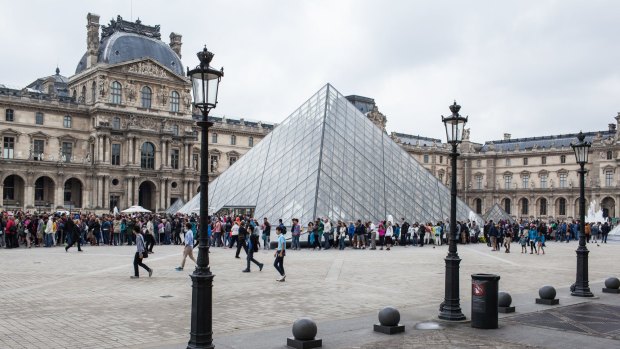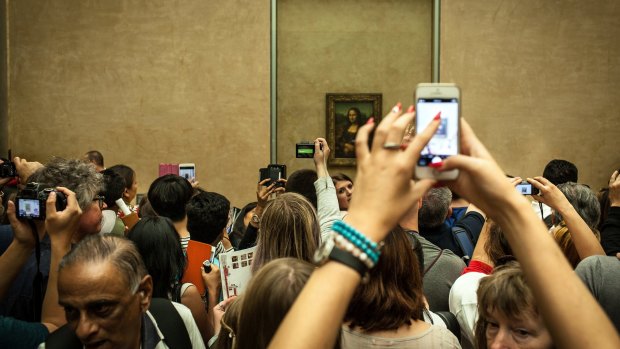This was published 9 years ago
The Louvre, Paris to undergo $80.5 million revamp to make it easier to explore
By DOREEN CARVAJAL

Reducing the waiting time for entry to the Louvre is one of the new director's plans.Credit: Guia Besana
The storybook rise of Jean-Luc Martinez begins where he grew up, in a Paris suburb dominated by blocky public housing. It ends deep within the opulent palace of the Louvre museum, where he is plotting what he calls a "petite revolution."
Martinez, 50, son of a postman and the Louvre's president since April 2013, is moving quickly to make a democratic mark on the royal stronghold that has the most visitors of any museum in the world, 70 per cent of them foreign tourists.
A two-year, 53.5 million-euro ($80.5 million) makeover is underway in the vast reception area below I.M. Pei's glass pyramid, where long lines of waiting visitors stream into a chaotic, open space that Martinez likens to a noisy airport and that leaves many people disoriented and lost.
He is also revamping the museum's basic storytelling tools: almost 40,000 banners, wall text, signs and symbols that now explain its treasures in French. The plan is to make them more readable and concise, in English and Spanish for the vast majority of visitors searching for cloakrooms or the Mona Lisa in the sprawl of a museum that dates to 1190, when it was a fortress for King Philippe II.
In the past, museums catered to visitors schooled in art history, with detailed information like a book and "chapters, titles, paragraphs," Martinez said, striding in a dark suit and tie by a marble centaur and a wounded alabaster Galatian in a gallery where a 17th-century king once meted out commands. "Our museum is not a book. It's something physical. It's necessary to move things around to try to increase understanding of our art."
His strategy to "think of the visitor" also reflects a museum trend toward creating narratives that are more relevant to a changing demographic. As major museums strive to become more mainstream and less elitist, most of the Louvre's 9 million visitors tend to be newcomers and art novices and it is searching for ways to make their experiences more meaningful.

She's back there somewhere: crowds viewing the Mona Lisa at the Louvre.Credit: Guia Besana
"For nearly everybody, museums are scary spaces," said James M. Bradburne, director of the Palazzo Strozzi in Florence, who has lectured widely on how museums can engage audiences more effectively. "It's like going into the city for the first time. There aren't signs at every point. It is very true that at the Louvre - and every museum - we underinform visitors."
The idea is to help newcomers crack the code, with clear information to interpret a vast trove that includes the Venus de Milo, "Winged Victory of Samothrace" and the colossal statue of Ramesses II. Martinez is also reducing temporary exhibitions to make way for an educational space for Louvre artworks grouped around revolving themes such as mythology and the origins of civilization.
Martinez, a descendant of Spanish immigrants who came five generations earlier from Almeria, in southern Andalusia, grew up in Rosny-sous-Bois, a working-class suburb east of Paris. He said he reflects the demographic evolution. His own first visit to the Louvre was a history class trip at the age of 11. When he came home, he said, he told nothing to his parents, who had never taken him to a museum.
"I lived in a suburb that was very modern, and everything was new," he recalled. "And when I arrived here, everything was ancient. Imagine for a child, to see five centuries of art, some as old as two or three millenniums. In this space, I felt the depth of human history."
To this day, his 82-year-old father has never visited the Louvre, where his son has worked since 1997 as a curator and the director of the museum's Greek, Etruscan and Roman department before becoming president last year.
It is a far different profile from his patrician predecessor, Henri Loyrette, a lawyer's son who socialized with wealthy art patrons like French luxury tycoon Francois Pinault and presided over the museum's expansion to a satellite Louvre-Lens in northern France and the Abu Dhabi Louvre scheduled to open late next year.
And since Martinez's arrival, some critics have sniped in the French press, labeling him "anti-mondain," uncomfortable with high society and neglecting rich patrons at a time when French museums are facing reductions in state subsidies. The Louvre, with 2100 employees, will receive 102 million euros in state funding next year, but its makeover is financed by money flowing from the Abu Dhabi satellite in the Emirates, which is paying the Louvre 400 million euros for the use of its name alone.
Martinez scoffs at the criticism, saying sponsors are vital to museum strategy. But he said it is evident that his family background influences his quest to "search for our public, to make our museum more open, easier to understand and to access."
He tested the Louvre experience as a tourist last year. His wait in line dragged more than 2 1/2 hours, he said, an annoyance he intends to reduce by expanding entrances to five from three. That will allow the Louvre to control traffic as it ebbs and flows, also making the grand entrance easier to navigate by rearranging information desks and ticket counters in a more logical fashion.
But as a global museum, he concedes there are limits, such as the glut of selfie-snapping crowds surrounding the Mona Lisa.
"There are no miracles," Martinez said, adding that he intends to drive traffic elsewhere, diverting some of the more than 850,000 French students who visit yearly to an educational space with revolving exhibits.
His new strategy has clearly struck a chord with visitors suffering the anxiety of being lost in the Louvre.
"We couldn't find the Michelangelo paintings," said Berke Erat, 24, of Turkey. "It was actually like being in The Da Vinci Code.'"
Naama Barel, 27, of Israel, navigated by retracing the same path. "I was really depressed that I didn't take the audio guide, because all of the descriptions were in French. Other than that, it was amazing."
When Martinez strides through the Louvre, he becomes the university archaeology professor he once was, pointing out shortcomings.
"Look at this," he said as he paused to peer at a sign. "It's in English and such tiny print. Who can read this? Who?"
Part of his work will be to attract more French visitors, whose numbers have been slipping, particularly the young, such as Kimberly Sebas, 18, a fashion student, who described the Louvre as a labyrinth.
"It's not easy to find the way," she said. "It's really big and really difficult, and without our professor, we would be lost."
Experts give Martinez credit.
"A major institution like the Louvre has such organizational and political and historical momentum that it's like moving a supertanker," said Bradburne, who noted that the Louvre's new 18th-century decorative arts wing was confusing because it was difficult to tell whether objects were antiques or recently made.
"By trying this," he added, "Jean-Luc Martinez is being a hero."
The New York Times
Sign up for the Traveller Deals newsletter
Get exclusive travel deals delivered straight to your inbox. Sign up now.